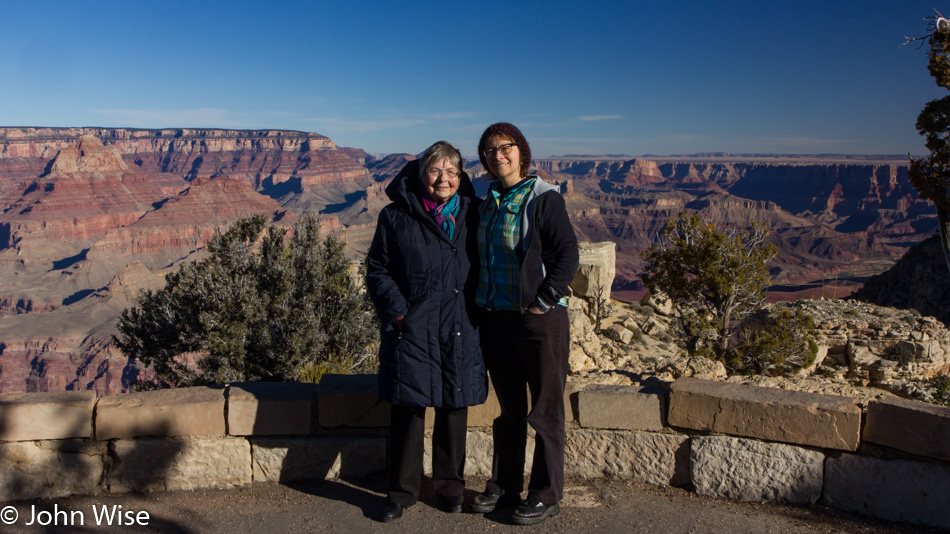
The last photo of Caroline and her mom at the Grand Canyon and while sad on one hand, there are a thousand incredible memories shared here at the edge of this vast place of wonder.

The last photo of Caroline and her mom at the Grand Canyon and while sad on one hand, there are a thousand incredible memories shared here at the edge of this vast place of wonder.
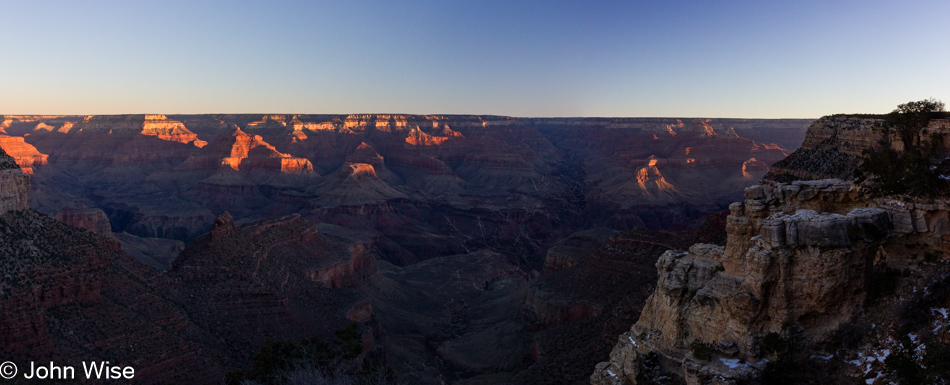
While it might have pained Jutta to rise so early on freezing cold days, there’d be no missing sunrise in the Grand Canyon. There weren’t many photos taken and shared across these posts as on previous visits to the United States; we made every opportunity to capture the moments of my mother-in-law in every new place she visited. This trip was not only her last, but due to the hip she broke earlier in the year, her mobility wasn’t the best, so we just took things easy.
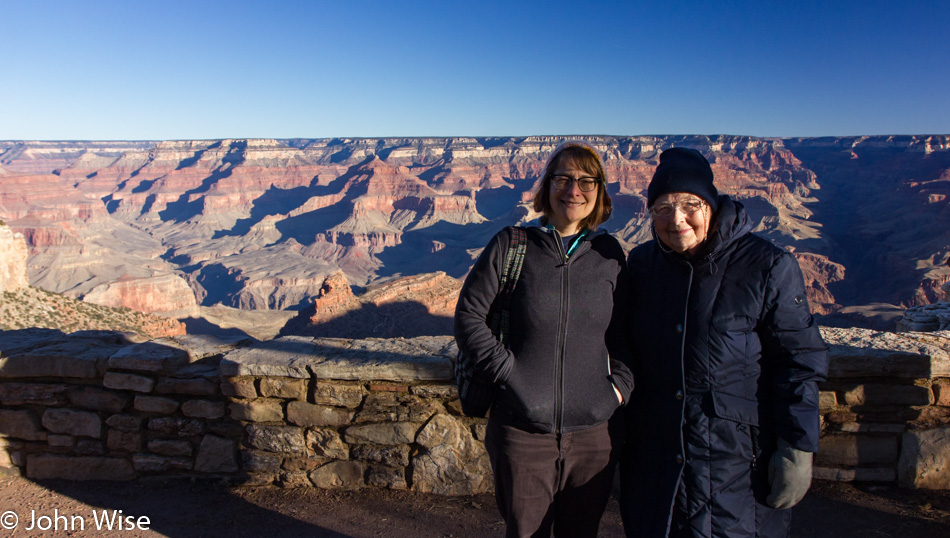
Of the other photos of our day spent along the South Rim of the Grand Canyon, this is the only one that really mattered.
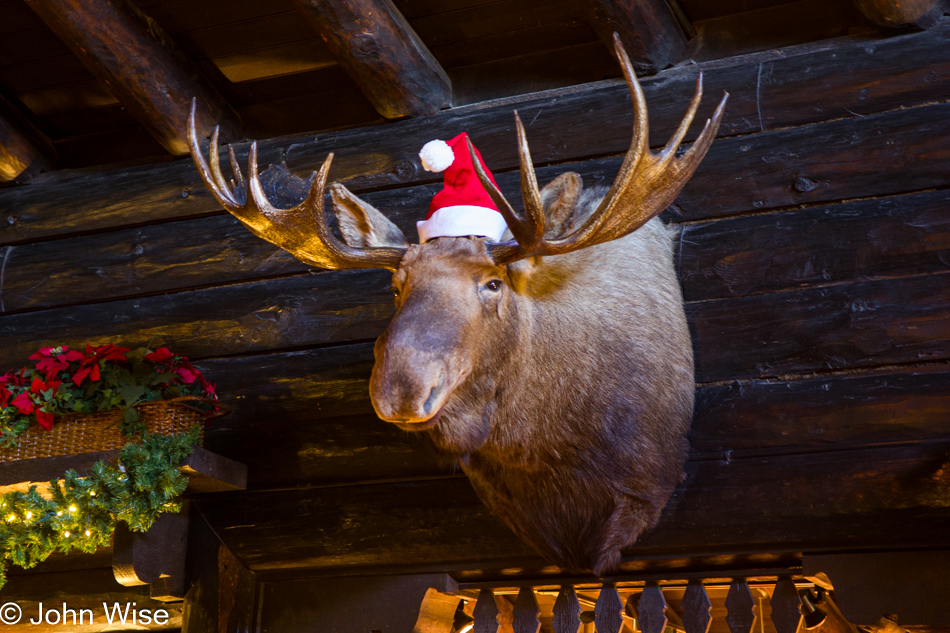
Just spending time with Jutta was enough and really, that was all she ever wanted anyway. Well, that and to laugh.
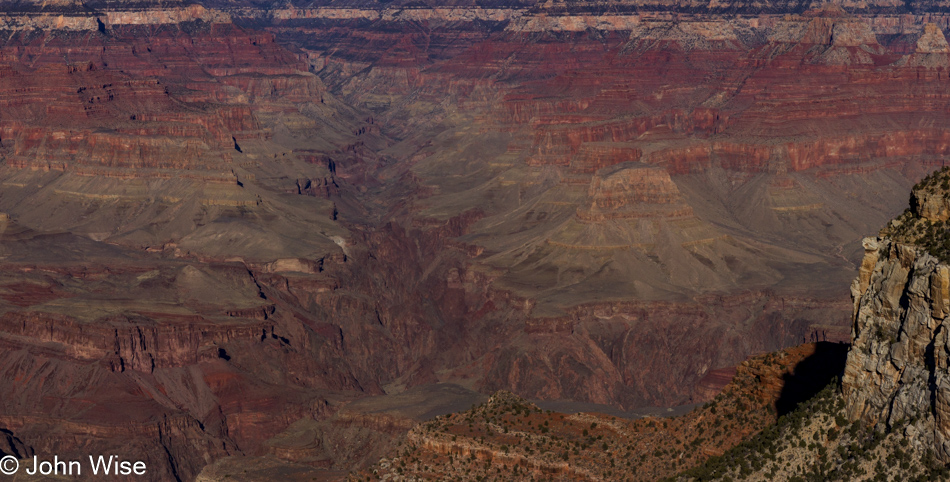
As it grew late in the day, we took in as much of the sunset as we could before heading in for an early dinner and sitting around chatting on Christmas Day.
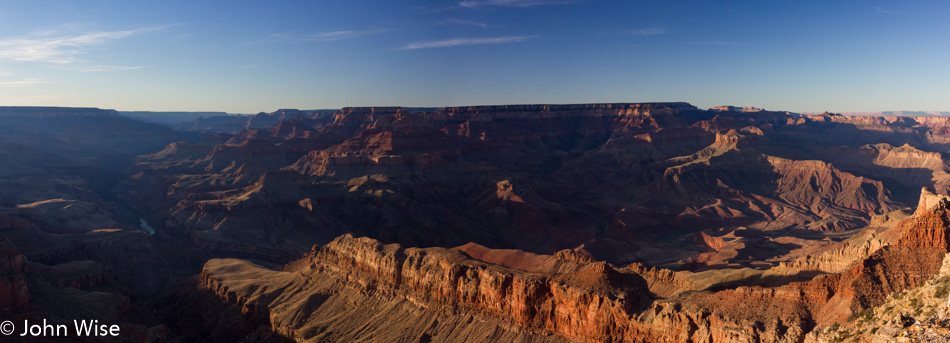
It’s Christmas Eve, as we arrive late in the afternoon to catch the sunset in the Grand Canyon National Park.
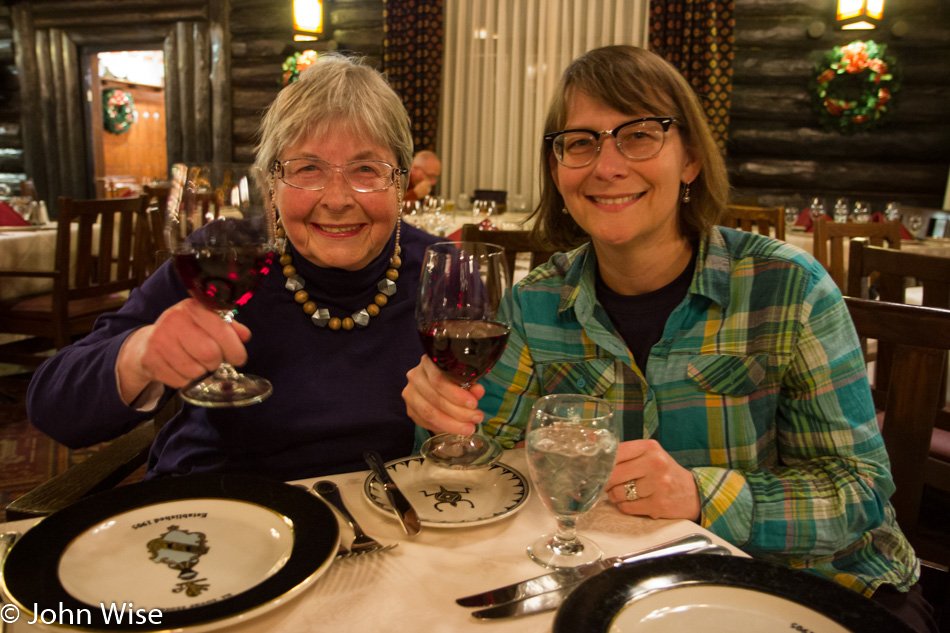
This is Jutta’s first Christmas visit to the Grand Canyon of the nearly 12 times she’s been to this park during the ten trips she’s made to America. The Grand Canyon was a dream come true for her, and she’s never bored in her many visits, but sadly this is her last time here. When we made this journey up north for the occasion, we were aware of my mother-in-law’s growing physical weakness as she’s 78 years old in this photo, but the other part of the situation that’s looming is her declining memory. I can’t help but look at this photo and now see it as a toast to all the incredible times the three of us have spent together over the years her daughter has lived so far away. I’d give anything to see this old lady in the El Tovar once more for dinner and to wake up the next morning for sunrise over one of her favorite places in the world. Fröhliche Weihnachten forever, Jutta.
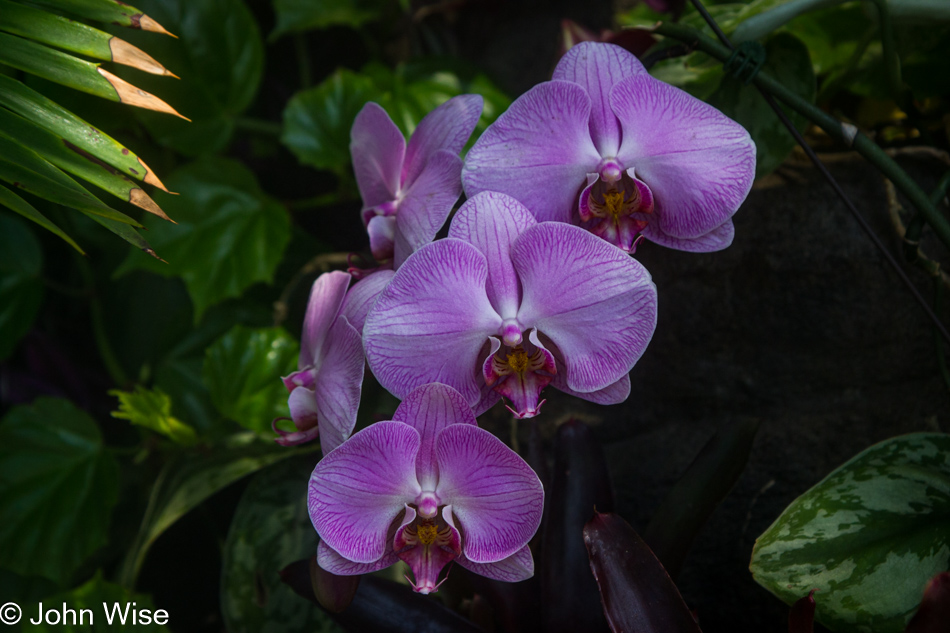
Before heading out of Denver this morning, I have another request from Caroline to satisfy, and that’s for us to visit the Denver Botanical Garden. You can rest assured that these orchids are not near our motel because our typical lodging arrangement is more likely to smell of cigarette smoke, stale beer, and a hint of urine and located where, at best, weeds might be growing. Where exactly we stayed is lost, lost, lost, as are many details about this trip to Denver because, once again, this is another of those posts that arise from a forgotten past when, for reasons beyond the timeline of active memory, there was nothing ever written or noted about this visit and so in 2023 I’m here at work trying to assemble something that might reflect relatively accurately about the events of the day.
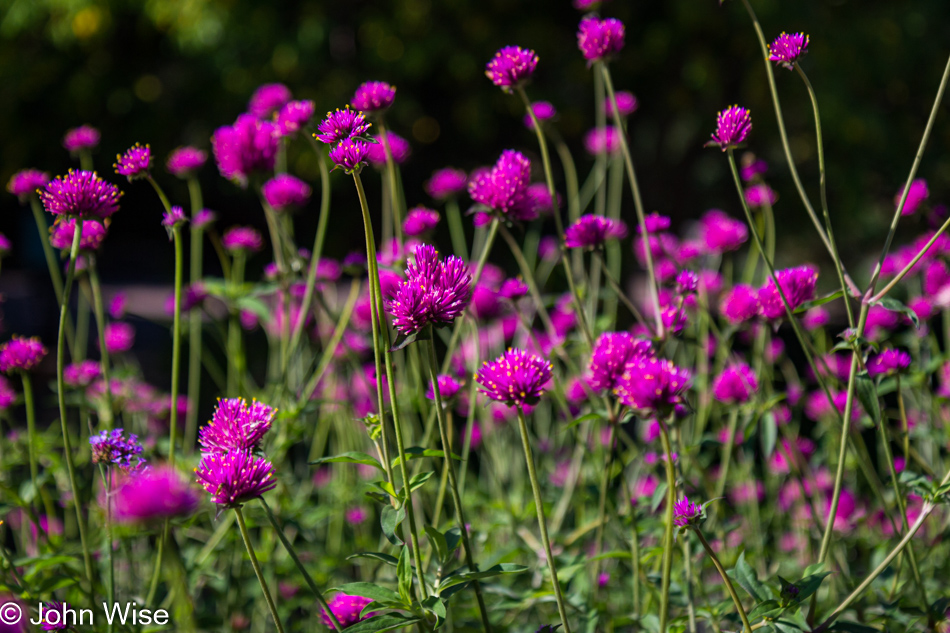
Searching for something to say about the garden, there was a moment when I thought I wanted to claim it felt like cheating to photograph gardens and flowers as everything is already organized, but just as quickly as I entertained that idea, I realized that photographing anything is in essence configured in a similar way as whatever the subject matter aside from people and animals, the scene is presented as the scene is. Still, there’s something that has me feeling like I’m adding filler with no valuable caloric content, just sugary convenience.
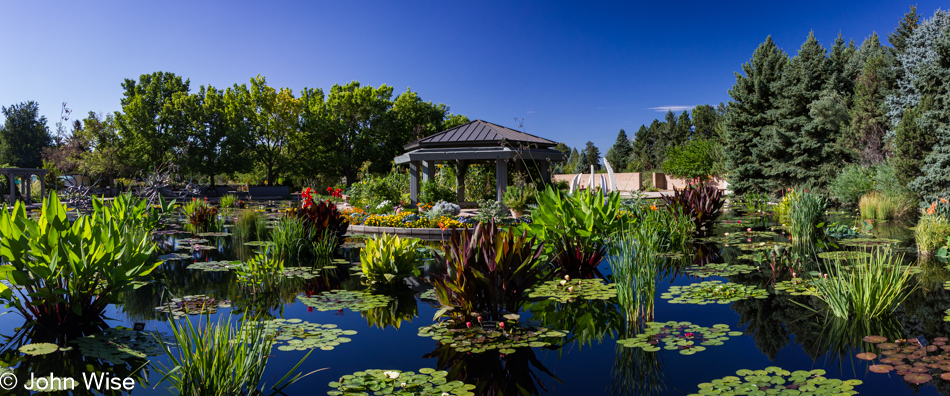
I spent nearly 90 minutes writing the previous two paragraphs, which could be more time than we even spent in the garden; such is the nature of scouring a mind, looking for any hint of impressions that might have been made a decade earlier. One could be wondering what the importance is of backfilling this stuff, and my answer is that without the photos up here, they are lost in the depths of my hard drive where we rarely, if ever, look back at the photos occupying those magnetic particles. Take this post where I’m sharing 17 of what I felt were the best photos on the day we were visiting Colorado. I shot 229 photos, and the majority of them should be tossed. The tedium of going through so many photos to reacquaint ourselves with memories would be cumbersome, while here on the blog, we can do a quick scan of a day to pick up the high points, and if we are so inclined, we can read a little something or other that might offer us a chuckle.
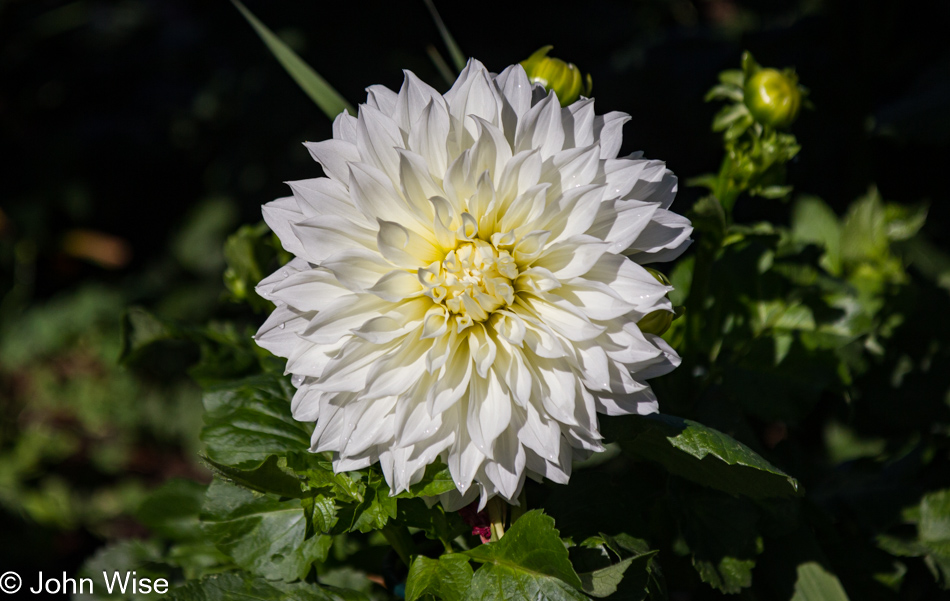
Maybe I have a small disconnect with flower gardens in that I’m not sure where they come from. Take this dahlia; where do they grow wild? After a little search, I learned they originate in Mexico and Central America, while roses came from Central Asia. I’d wager that my relationship with flowers was negatively influenced by the fact that in my childhood, I only ever saw them in stores and that they now feel like some kind of cultivar only created for human appreciation, kind of like chihuahuas.
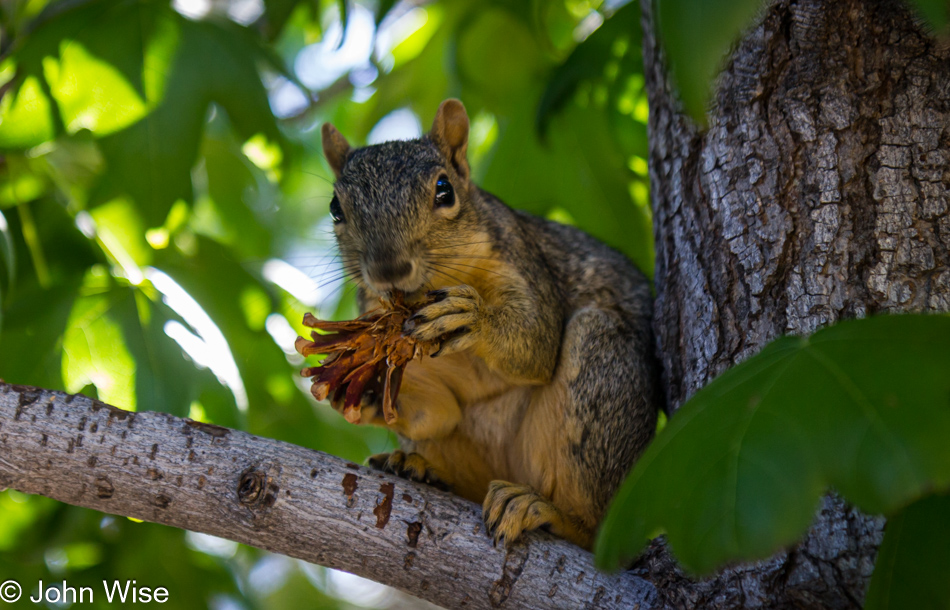
While still at Wikipedia, I thought I’d look up something interesting about the squirrel, and well, there’s little that’s really interesting about this furry creature. But then, just as I was about to turn away, I gave a second thought to its name, which in Old English was Ācweorna, that gave way in the days of Middle English to Aquerne; both words are cognates of the German word Eichhorn. Look closely at the English variants, and you should be able to see the similarity. Obviously, we are not near squirrel yet, which would be influenced by the Anglo-Norman French word esquirel, which came from the Latin sciurus (which in turn is derived from Greek skíouros, which means shadow tail). For those of you who might not know much about the English language you speak, its origins are mostly found in French and German, with nearly nothing remaining of the original forms of English in the modern tongue we use.
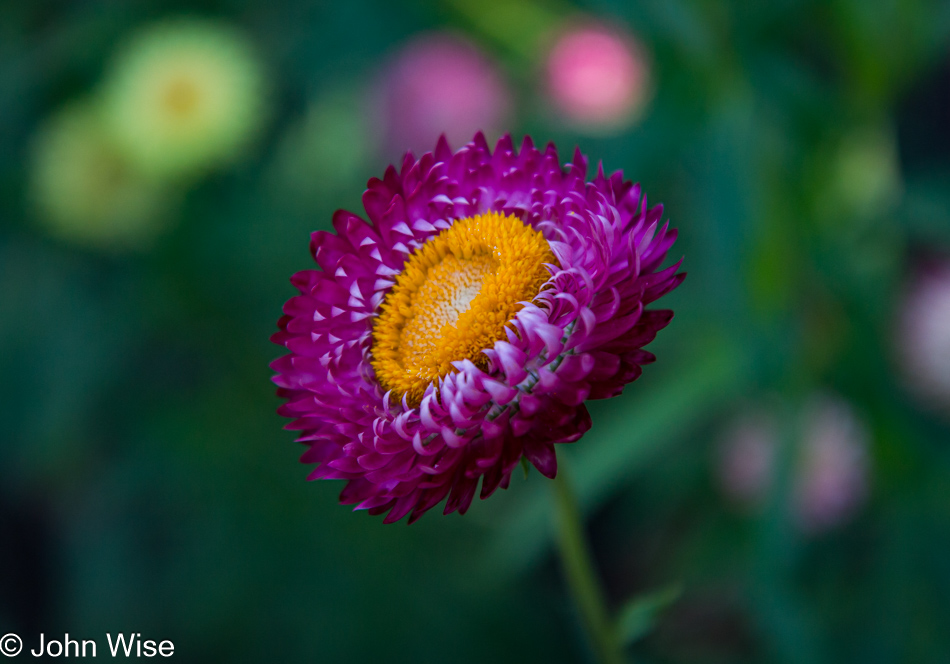
Going out on a limb here by claiming this might be a magenta strawflower.
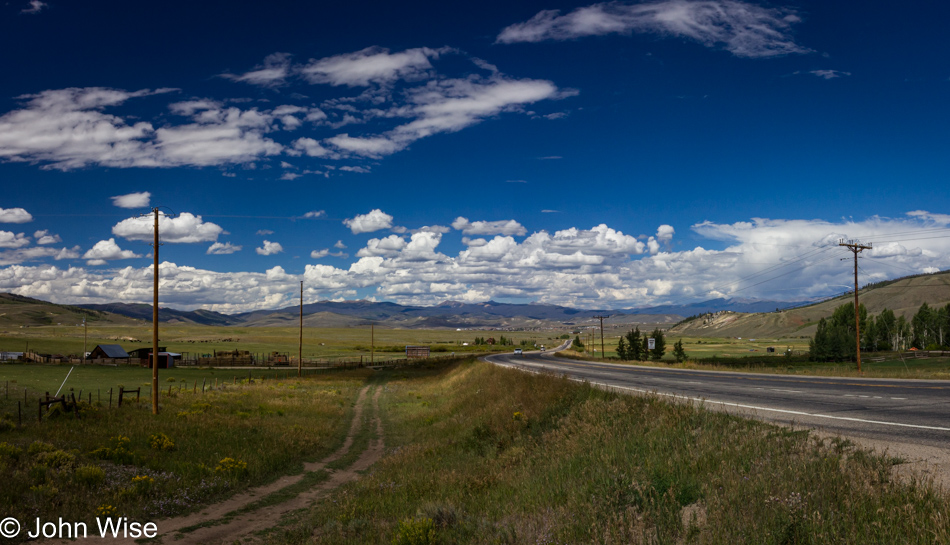
It was now time to head up into the mountains, the Rocky Mountains National Park, to be precise. For one reason or another, we opted to travel the southern boundary and enter through the western gate. Maybe it was meant to facilitate a loop around and through the park, but without afternoon photos, I wasn’t able to decide with any certainty. What I am confident about is that we had beautiful weather for our visit.
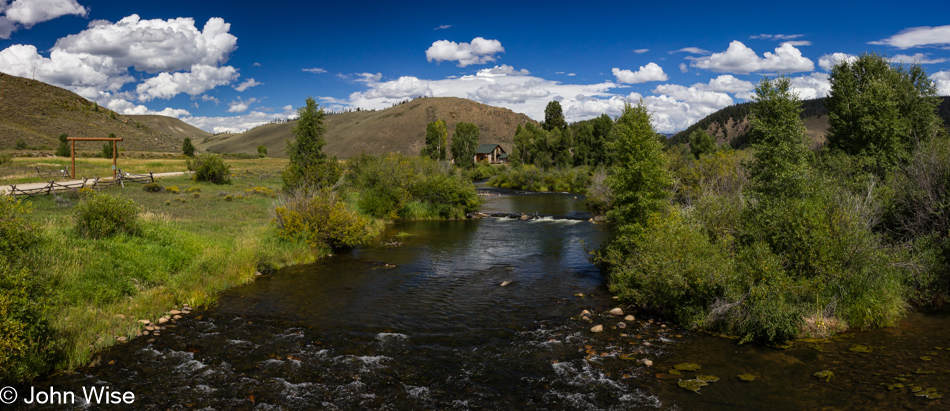
I wanted to believe that this is the Colorado River but after chasing the road using Street View, I can’t figure out anything about the location.
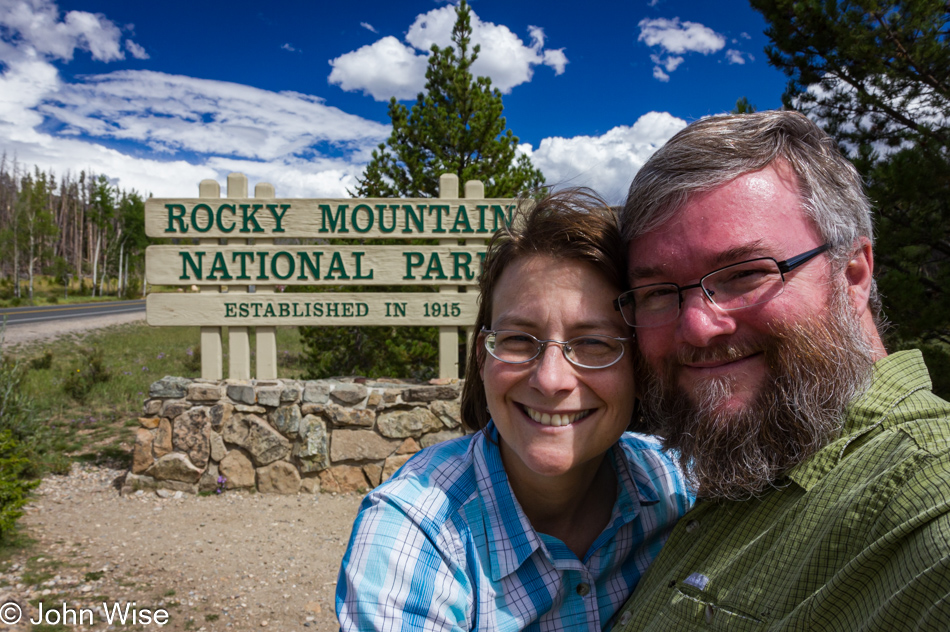
Entering the Rocky Mountain National Park via Trailridge Road on the west side of the park just north of Grand Lake. I’m certain about this fact, as the rock layout of the foundation of this sign matches the Street View capture. Looking back at this 10-year-old image of me, I can better recognize the amount of gray hair that was appearing and realize that it didn’t happen as quickly as I sometimes fear. As for Caroline, and I’m sure she’ll disagree, she looks exactly the same, though she’ll point out that she now has about 30 gray hairs at the center front of her hairline; big deal because I now start looking like Santa Claus.

Thanks to the good ‘ol internet for reminding me that we are at the Continental Divide in front of Poudre Lake. By the way, you may notice here that the weather is changing. Look closely and you might catch a whisp of a rainbow that’s over the small lake right near the short here.

We are in front of the Alpine Visitors Center
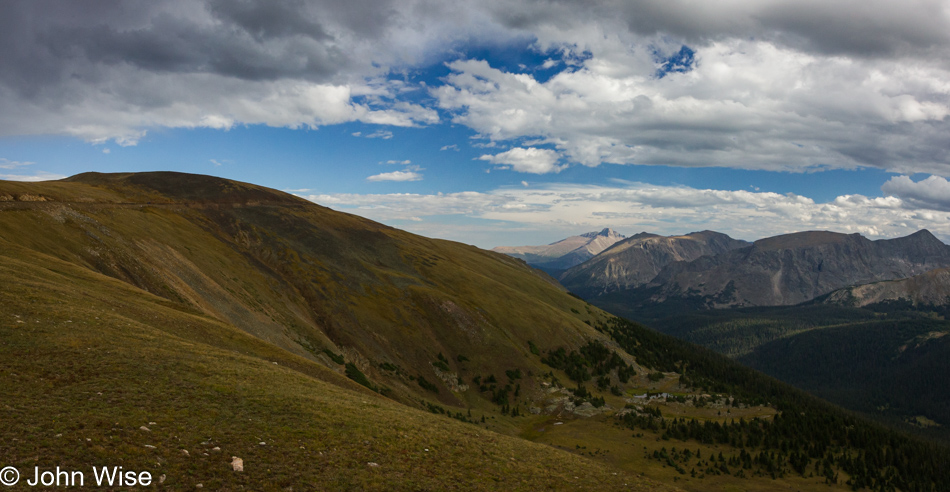
Hunting for sunshine and blue skies limits the direction I’m taking photos. With the change in conditions, you can bet we’ll have to plan on a return visit to capture the vistas under optimal conditions.
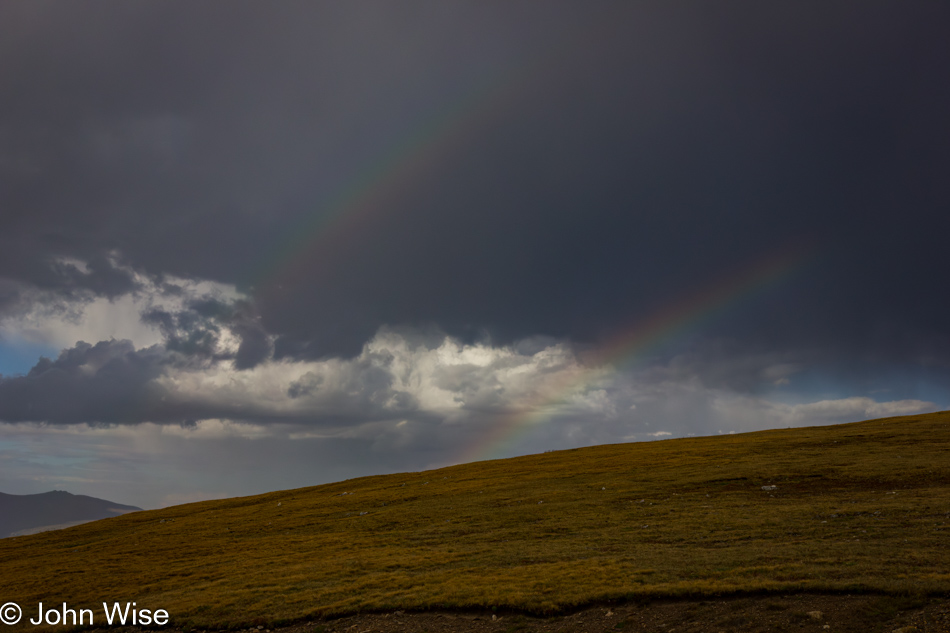
While faint, there’s nothing wrong with double rainbows to brighten the heavy clouds marching in.

We never expected that our visit would turn into a trip to the Rainbow Rockies.
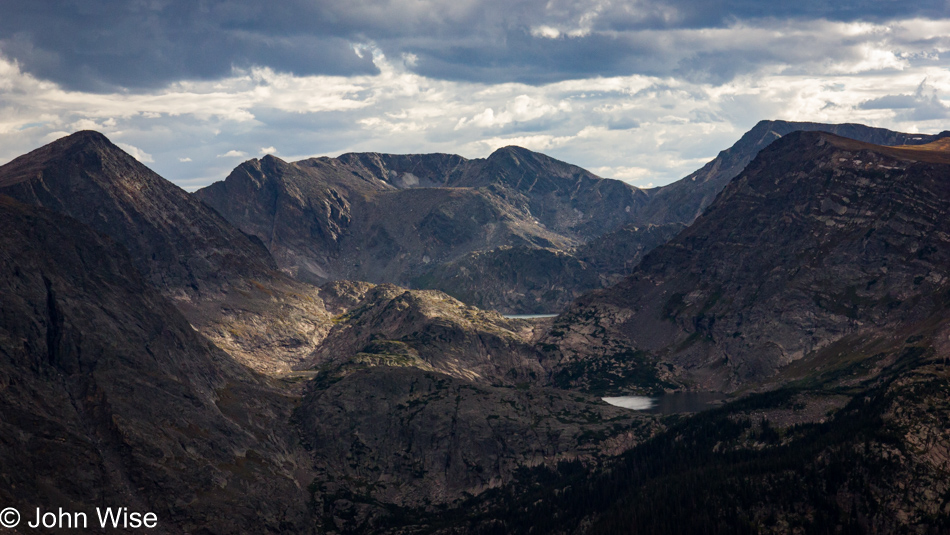
The elevation up here is no joke, with me getting dizzy every time we step out of the car. Hopefully, upon our return on a future visit, we’ll opt to stay in Estes Park in order to acclimatize to the heights of this national park.

What a perfect example of the Clarks Nutcracker that posed for minutes, striking various stances for me to capture its elegance.
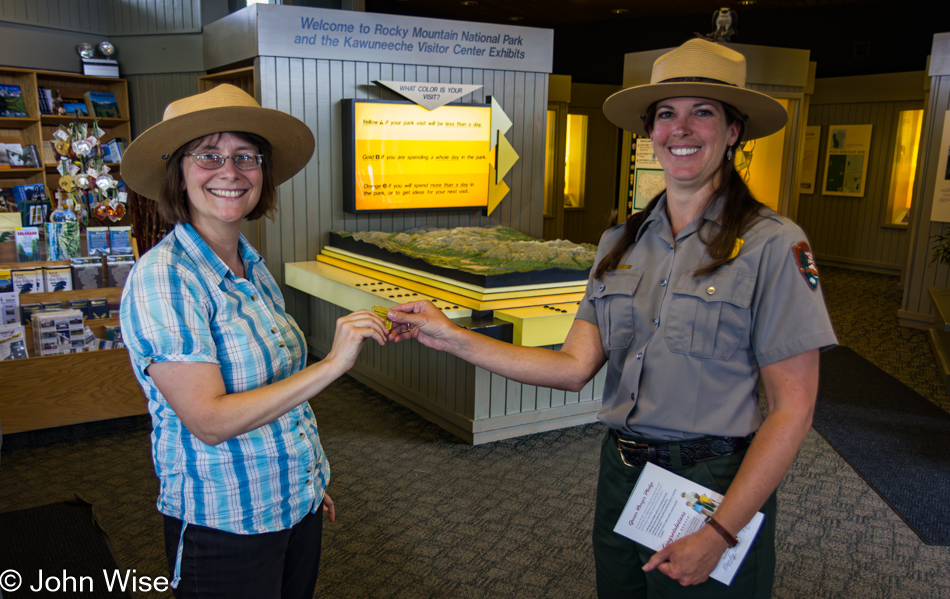
To the astute reader, you might recognize that this photo of Caroline earning her Junior Rangers badge was at the Kawuneeche Visitor Center, which is near where we entered the park, and that would be correct. It’s placed here at the end of the post, as I felt it was a good closing for this entry.
Following our visit to the Rocky Mountains, we likely drove back to Denver via Estes Park and then headed towards our hotel in Aurora. We dined at a Ted’s Montana Grill around the corner from the ALoft at the Airport. Afterward, we returned to our room because, at the break of dawn the next day, we were catching a flight back to Phoenix so that Caroline could go directly to work.
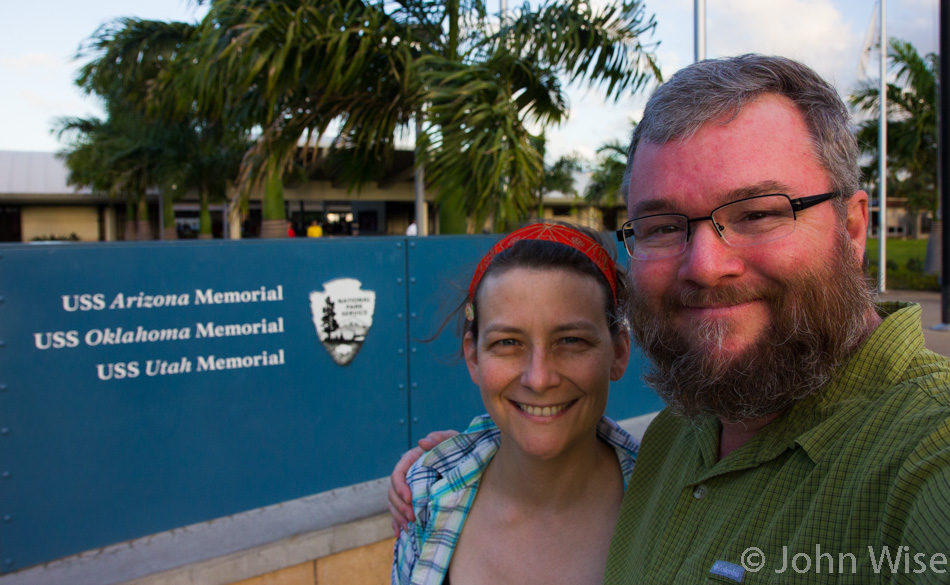
Up with an alarm and gone from the North Shore by 6:15 as we were heading back towards Honolulu for an 8:30 reservation. Should have visited Kalaupapa National Historic Park on Molokai back when we visited that island in 2006; then, after today, we would have visited all of the major National Parks in the Hawaiian islands. We are going to Pearl Harbor which is referred to officially as the World War II Valor in the Pacific National Monument. I suppose it’s okay that there are things that will be left undone out here in the middle of the Pacific that can draw us back for a third visit. So besides the former leper colony on Molokai, we still have to visit Lanai, hike the Kalalau Trail on the Napali Coast, swim with sea turtles (not really all that important), and go to an official luau at a resort – never mind, there is NO way we will ever do that – EVER!
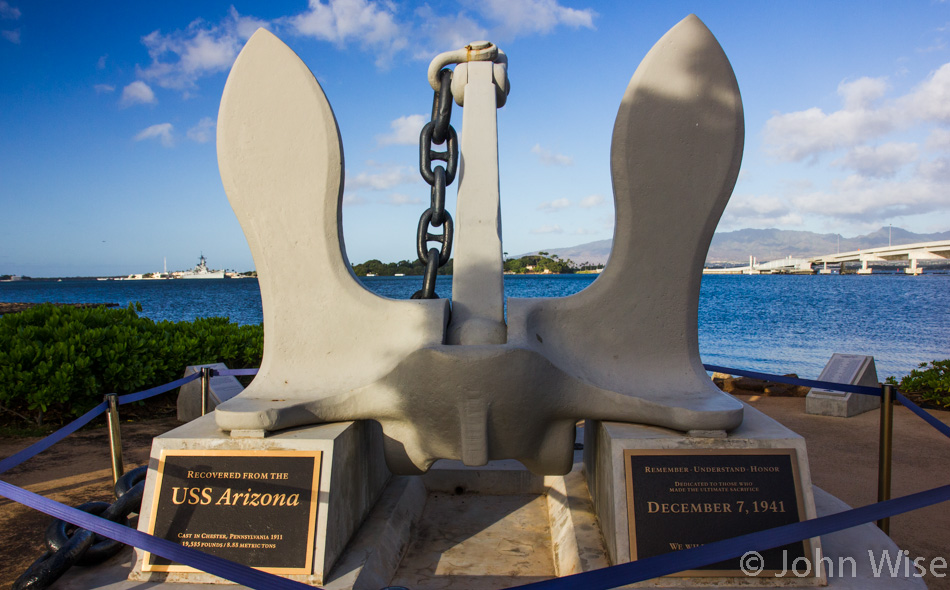
Before venturing further, Caroline has to stop at the information desk to collect her Junior Ranger booklet and get busy identifying what she needs to accomplish to be sworn in later as a Junior Ranger.
The USS Arizona, a pre-World War I “super-dreadnought” battleship destroyed during World War II, is the main attraction here at the memorial. At the time the ship was built, Arizona had just become the 48th state of America, hence the commemoration.
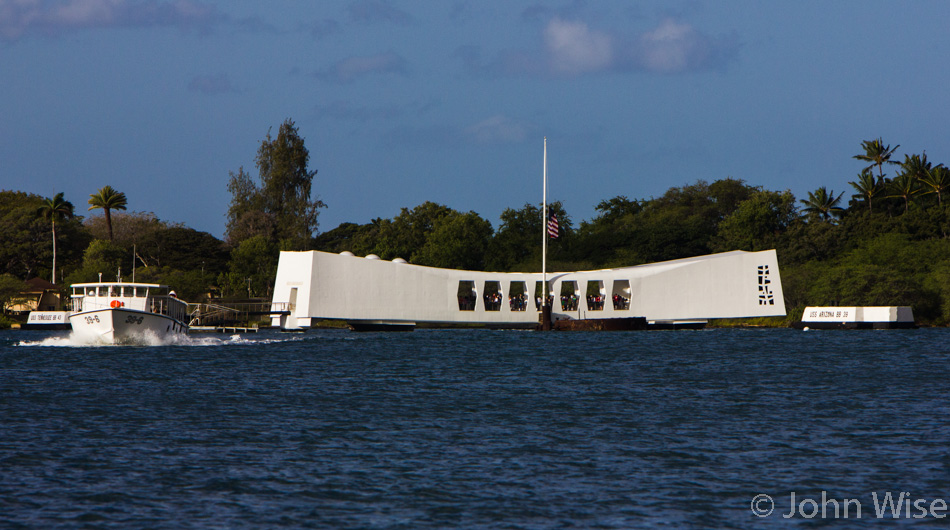
As anyone who is interested in visiting Pearl Harbor already likely knows, there’s a short naval boat ride out to the USS Arizona Memorial and the most iconic site here.
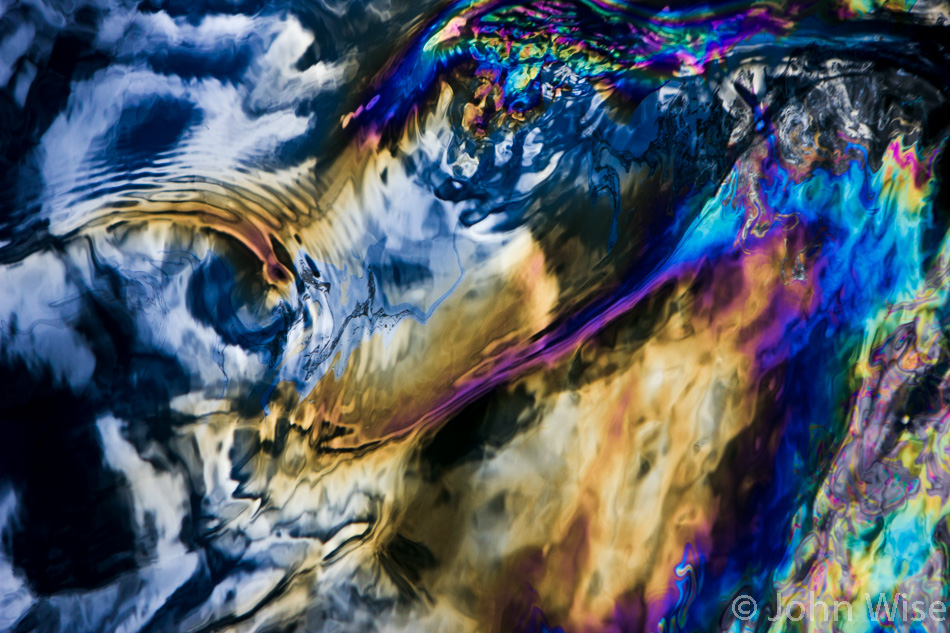
Almost 71 years to the day after the Japanese bombed this port and sank the USS Arizona, the oil still leaking from below is evident. In contrast to the tragedy, it is quite beautiful on the surface of the water.
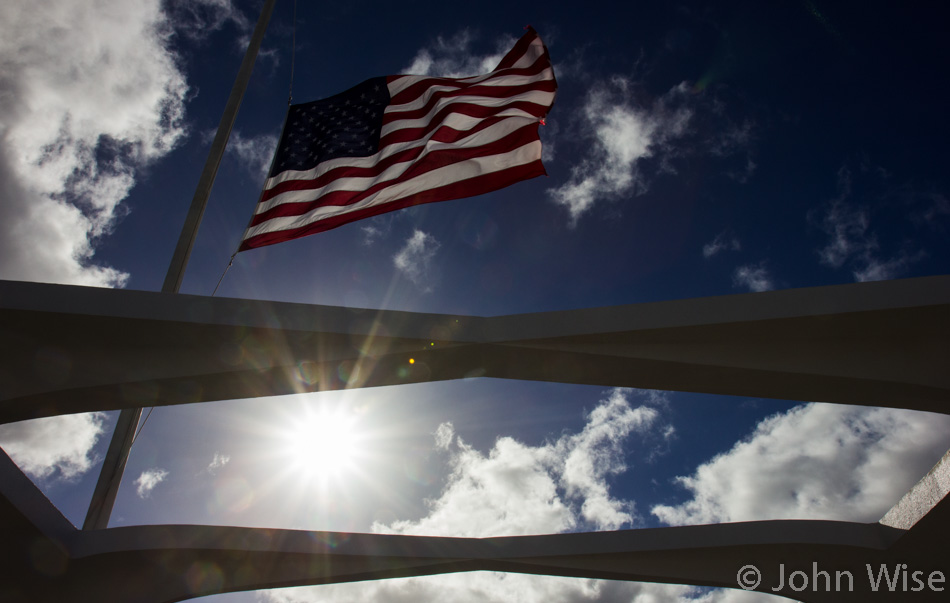
Fortunately, the visitors to this solemn place are acting accordingly and showing the respect that should always be afforded to locations where an act of barbarism took so many lives. This sense of physical presence of the tragedy is reminiscent of feelings had while visiting Dachau, Manzanar Japanese Internment Camp, Custer’s Last Stand, Gettysburg, and the Eastern State Penitentiary in Philadelphia.
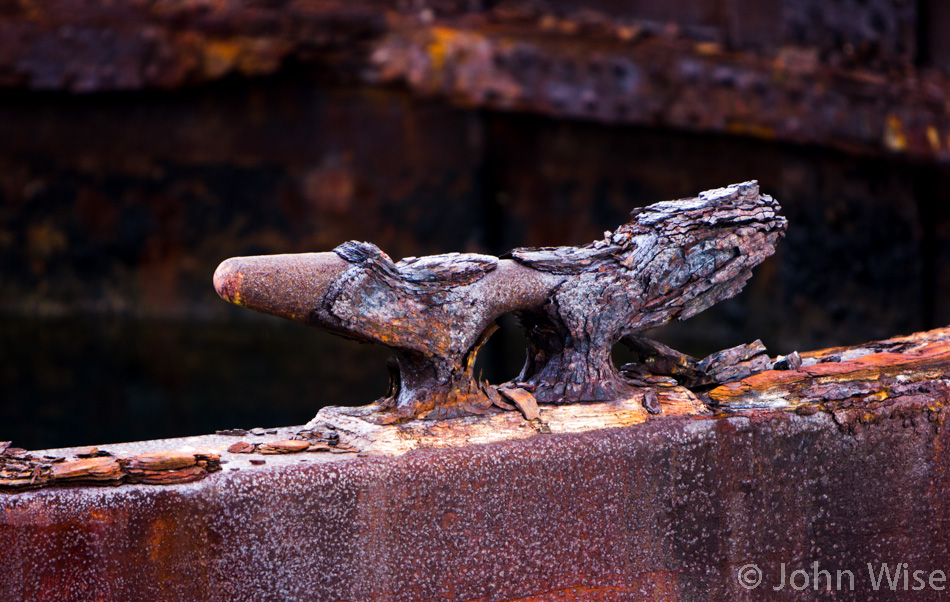
Usually, the place of a human death doesn’t immediately become a memorial. The evidence is removed from the place where it happened, as human remains are taken to a cemetery or to cremation. Here, we must confront that the rusting hulk of a vessel just below us still holds the remains of over 950 soldiers who died aboard this craft. They were not able to be brought by a family member to a proper resting place, but then again, what is more appropriate than using the site of a grievous act of war as a reminder of our transgressions that take so many lives?

A place of contrasts where the beauty of Hawaii is also the site of the beginning of America’s entering World War II, a harbor where the tropical setting of palm trees and the ocean is also the setting for a mass grave, where dark clouds loom over paradise.
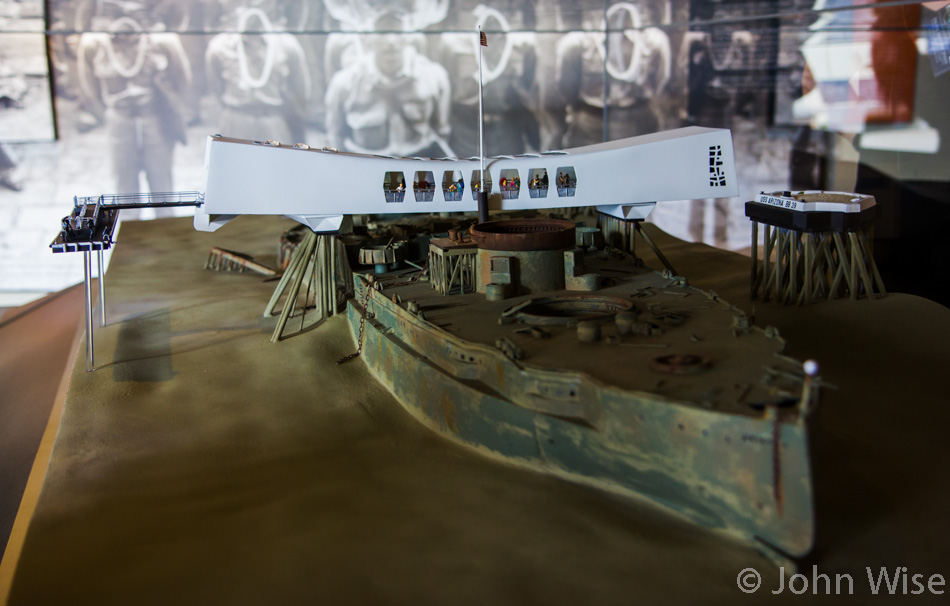
We see so little of the battleship standing out of the water, it’s difficult to imagine that there is so much ship just below us, but this model demonstrates the scale of what is just out of sight.
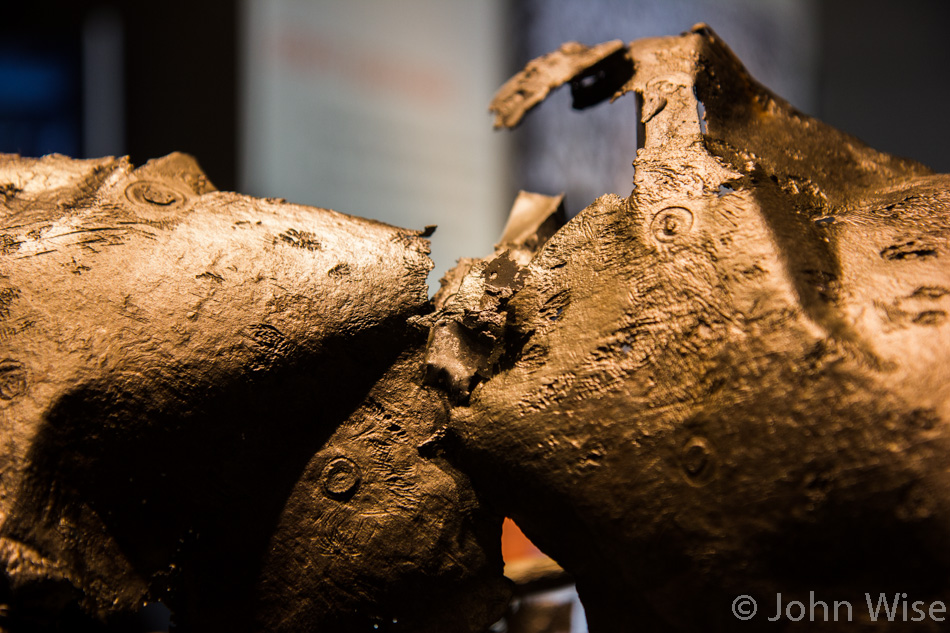
The museum back on the mainland has a great exhibit that goes into the details surrounding that fateful day. This piece of heavy steel shows what the force of the bombs was doing as they unceremoniously shredded into reality and tore at the fabric of our sense of peace.
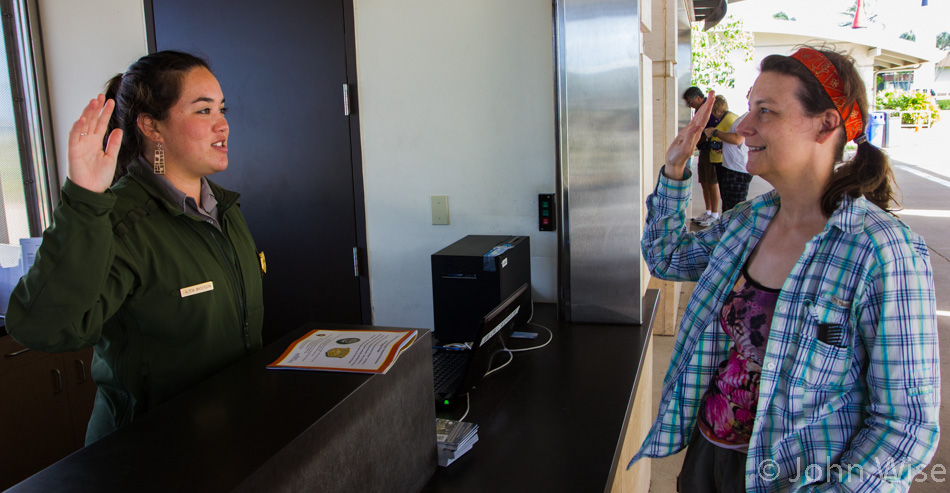
Like all National Park facilities, there’s a Junior Ranger program for those interested in learning more about the history and importance of a location while gaining a better understanding of being a steward of America’s most important lands and facilities. Caroline is collecting yet another nearly perfect score as she does her best in our rather brief visits to finish not just the requirements for becoming a Junior Ranger but to do all of the exercises and learn just a little bit more.
We left Pearl Harbor now hungry as our breakfast of bananas and pineapple was wearing thin. I’d already scoped that the Highway Inn might be a lunchtime winner, so we headed over to Waipahu and, in an unassuming strip mall, started our wait. Twenty minutes later, we had a small table and were trying to figure out what to eat. Considering this might be the first and last chance to ever visit this eatery, we got indulgent and started with an appetizer of Kahlua pork and purple yam in a quesadilla topped with mango salsa. Already, the meal was super yum squared. Next up was the laulau combo with pork and a side of squid lū’au. Determined to gain a wide sampling of their dishes, we ordered some of the made-to-order tako poke. In case you don’t know, or if Caroline is reading this to me when I’m old and in the throes of dementia, tako is the Japanese word for octopus. This dish is served with a creamy wasabi sauce, onion, and ginger miso, and it alone should have qualified the Highway Inn as great, but there was more. Haupia, oh my god, this was the greatest haupia we’ve yet had! And while it is just coconut pudding, it was the best coconut pudding.

Seeing that we were already in the Honolulu area, we decided to head over to the Bishop Museum, where Hawaiian and Polynesian history is on display. Our introduction to the facility was right here in the main hall and while difficult to see down on the ground floor, there was a men’s choir singing Hawaiian songs and lending a terrific start to our visit.
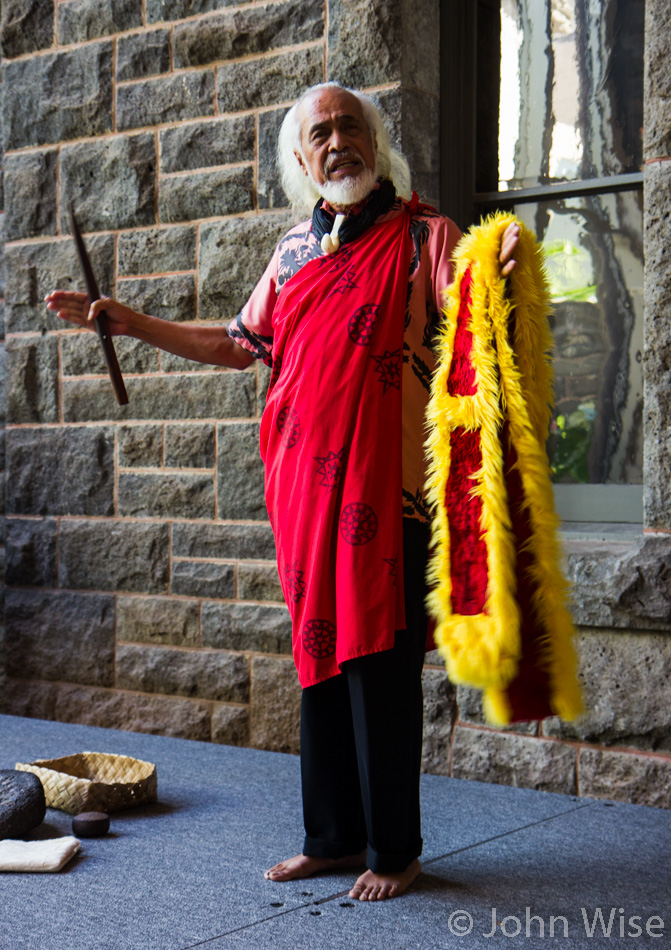
Our brief concert was followed by this gentleman giving a talk about clothing and feathers of which the exact details escape me as I’m trying to write about the day.
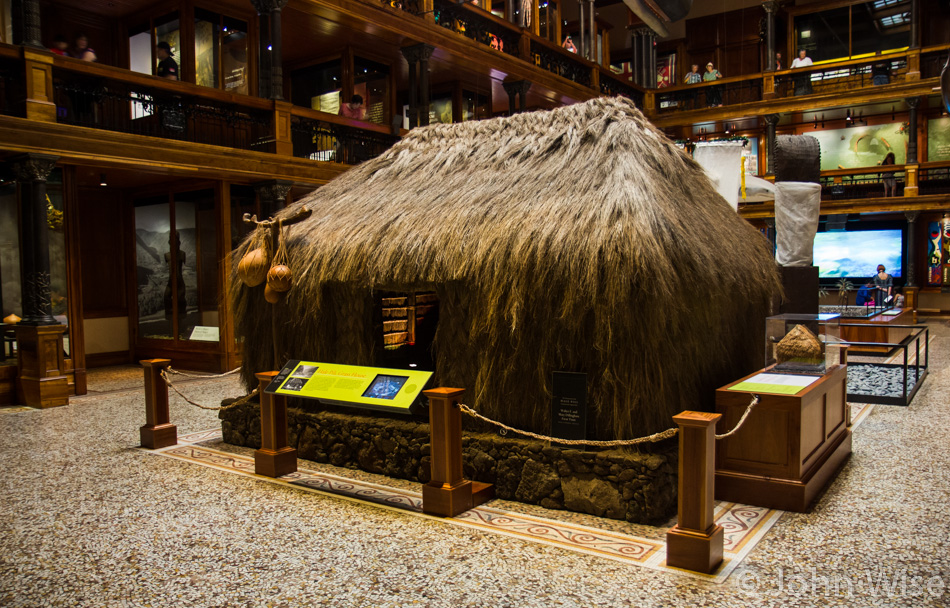
Along the way, we encounter a story that speculates that it may have been a group of people from Southeast China that had ventured away from the mainland and went on to discover and populate the Polynesian Islands before embarking on the journey over the ocean to populate the Hawaiian Islands. Funny how, growing up in America, I learned nearly nothing about the rich history of anyone else on Earth other than those we conquered.
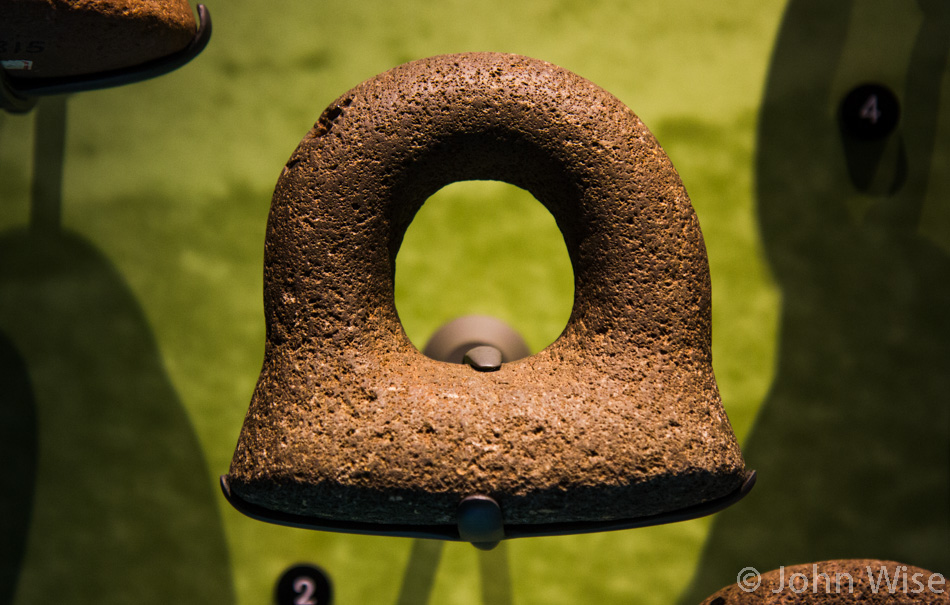
Stone and wood tools were common in Hawaii, as there were no early steelworks. Wood has a difficult time surviving the centuries, but there are plenty of stone artifacts here at the Bishop. This particular tool was used for mashing foodstuffs, particularly taro, for the making of poi.
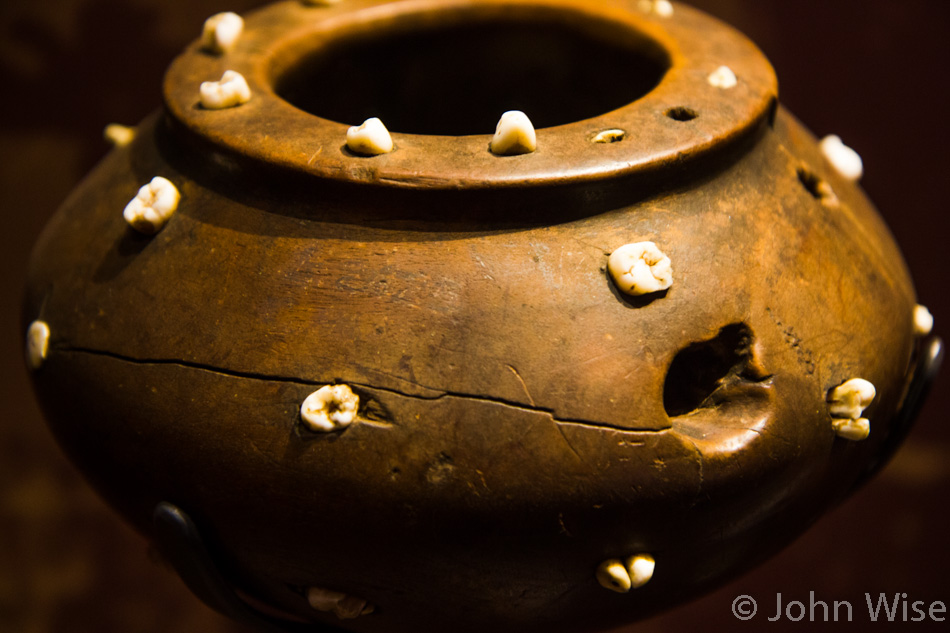
This urn with embedded human teeth is so interesting that I wish I’d photographed the card that explained its utility or symbolic meaning. So without that, I can only present you with an urn of teeth, not something I’ve ever seen in another museum or at any friend’s house.
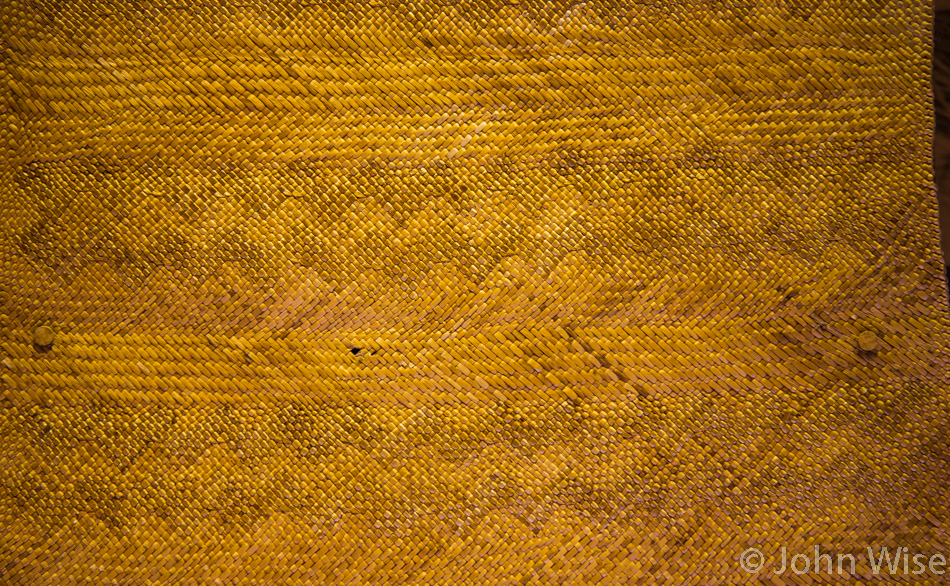
Weavings in the form of mats, basketry, and cloth are represented well in the museum with great examples.
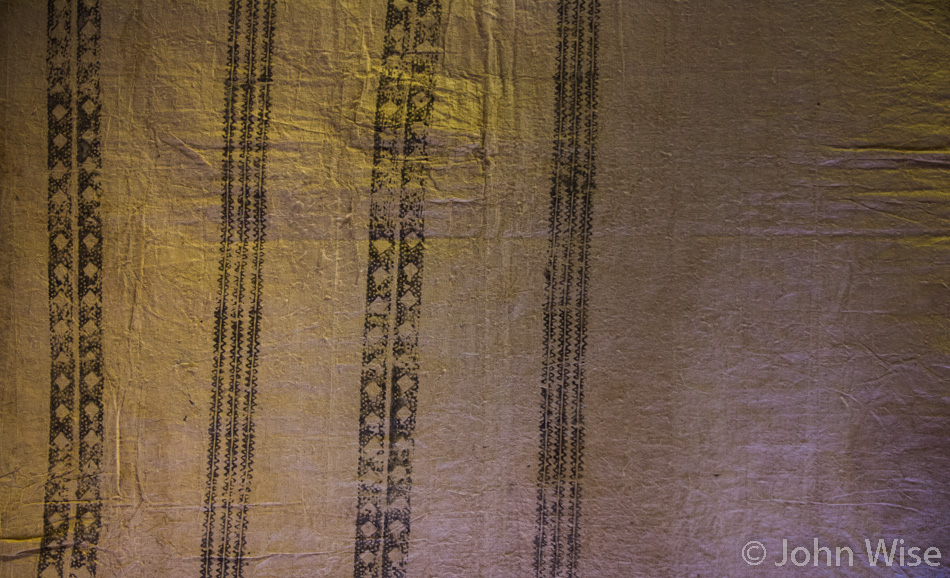
This is Kapa, as it is known in Hawaii; in the broader Pacific Islands, it is more widely known as tapa. Tapa, depending on how it’s prepared, can act as a cloth or be used as paper. It is often made of mulberry or breadfruit bark and was a common form of clothing before the introduction of cotton.
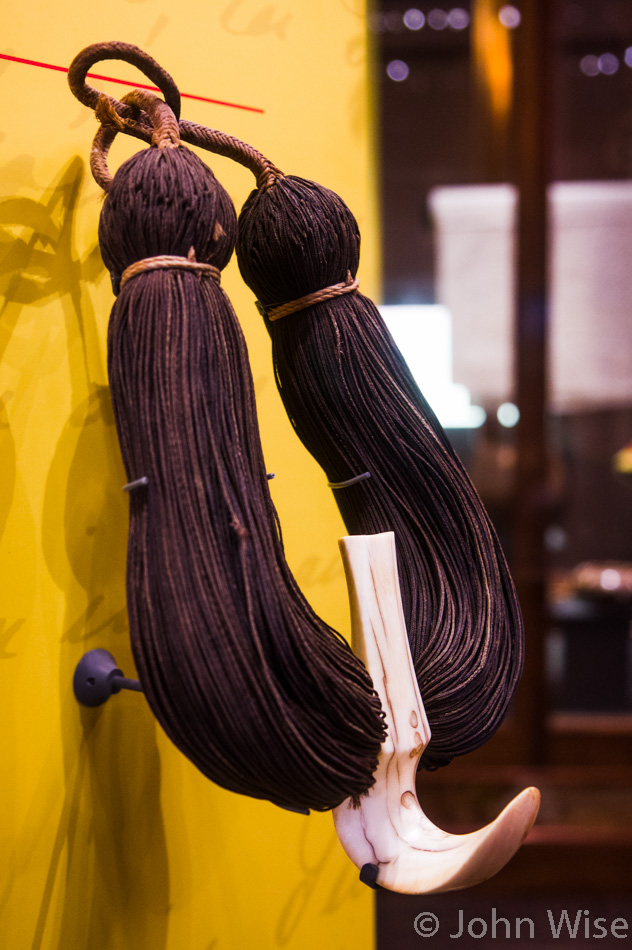
Lei Niho Palaoa, which is Hawaiian for a necklace of hair and whale ivory, is on display here. The hair was from a person of nobility and was diligently collected because it was thought to contain the power or “Mana” of the person it had belonged to. Interesting to see this mythology that there was strength and power represented by hair stretching from the Middle East to Native Americans to Polynesian culture, and it makes me wonder if the modern-day habit of keeping one’s hair cropped short and beard shaved clean isn’t a form of disempowerment.

The Ahu ʻula is a feathered cape made of hundreds of thousands of feathers that were delicately harvested a few at a time from living birds who were then set free to continue producing these valuable feathers. Why were they so important to early Hawaiians? Because the Ahu ʻula was worn by people of great power to provide spiritual protection. Seeing these in person is nearly as extraordinary as seeing the Grand Canyon with one’s own eyes; they are spectacular, profound even.
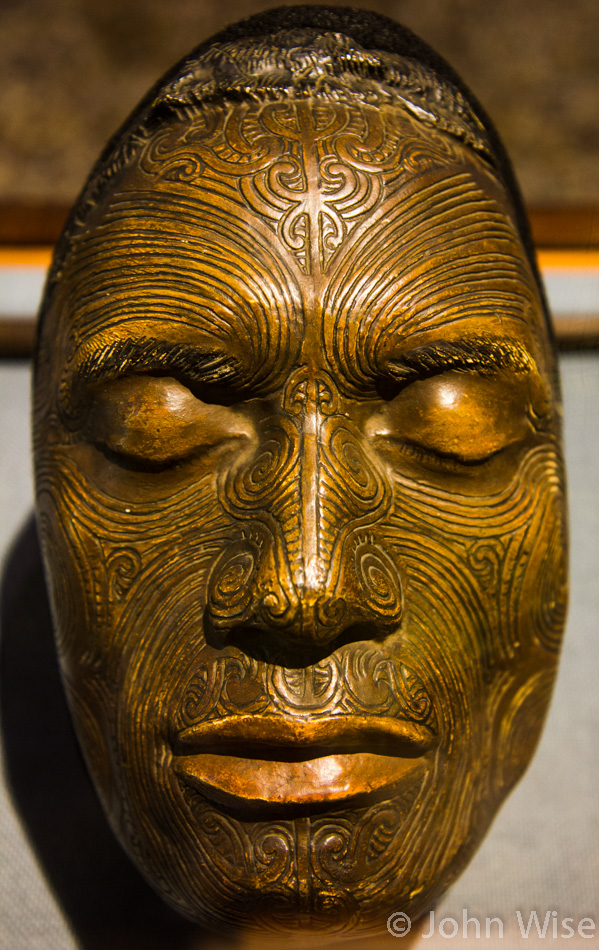
Masks of tattooed wooden figures are common among the Pacific Islanders, and as part of the culture and tradition of these areas, they are featured in the museum to help tell the story of customs and art shared across such a vast region.
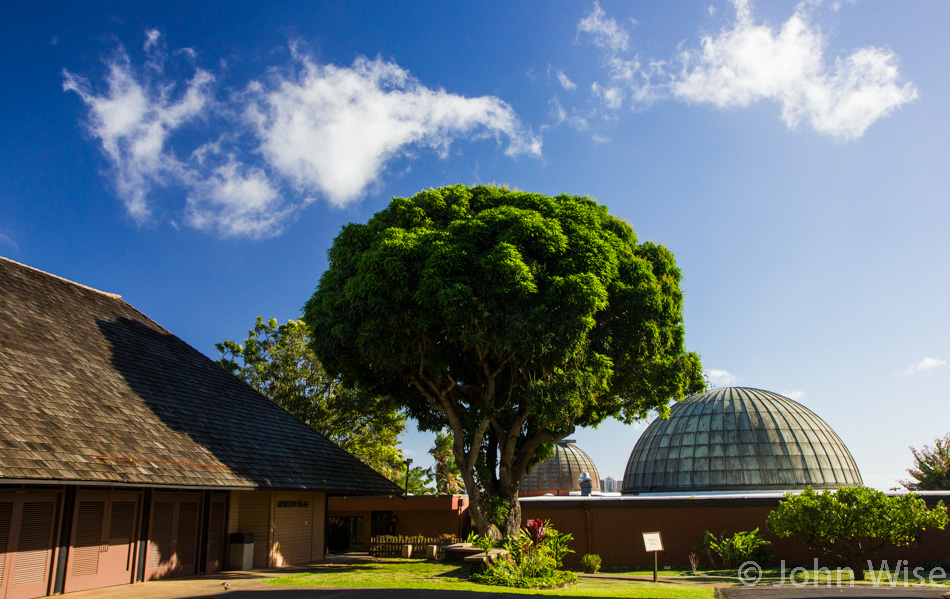
So, while we are a bit gun-shy and apprehensive about the tourist zones of Honolulu, Waikiki, and Diamond Head, we slowly warm up to their appeal, but probably more due to our interest in the history of Hawaii found here rather than the consumer and tourist culture. While still in the area with time to spare, we’ll continue on our exploration that started today in the southwest and trek up the western shore of O’ahu.
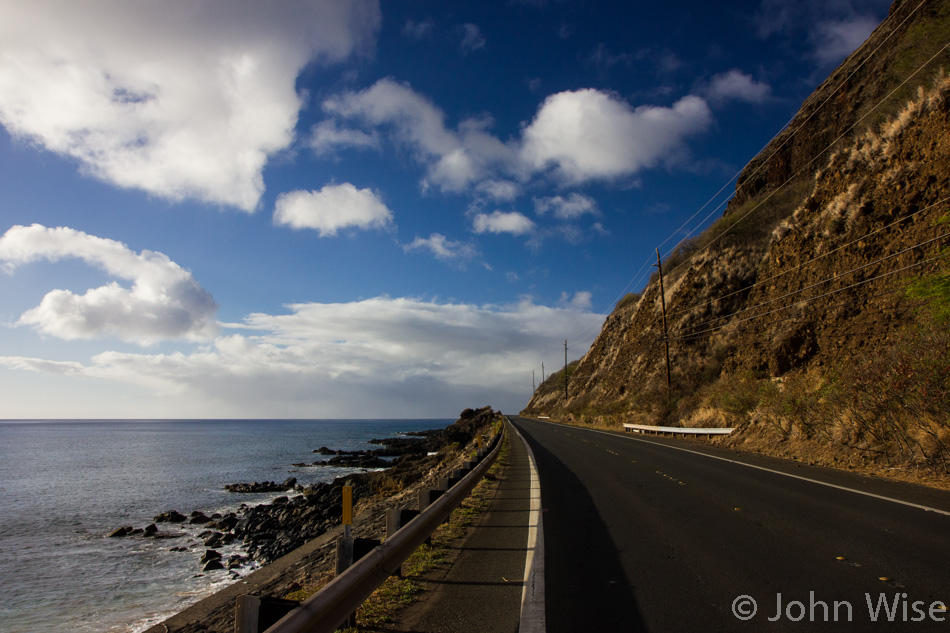
Our destination up Highway 93 is Kaʻena Point State Park. Wouldn’t you just know it, the side of the island that is a predominantly indigenous area would be the desert side?
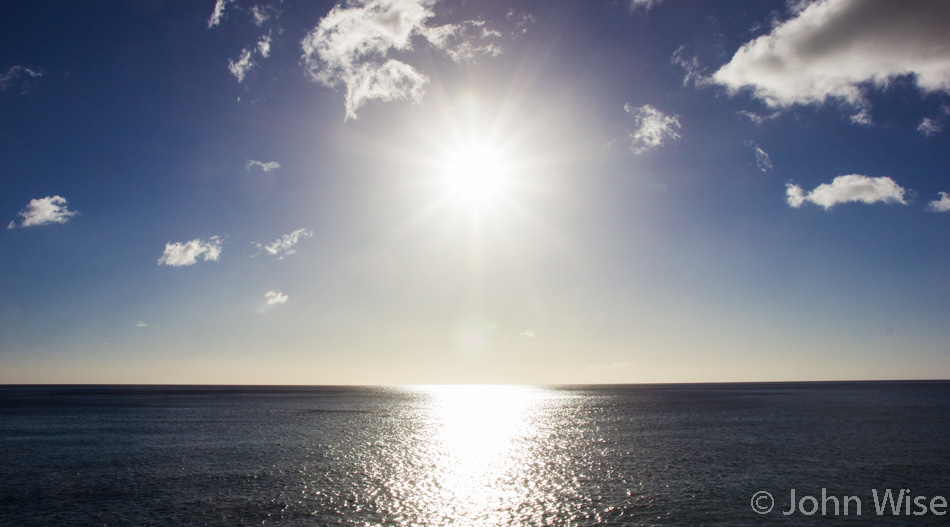
Compared to the North Shore, the ocean here is calm, with almost no surf.

With about two hours of driving to return to our lodging at Turtle Bay, we scope the area here on the western shore and quickly turn around to head back. On the other side of the island, we encounter a steady rain that is dimming our hopes for another spectacular sunset. No big deal, really, as we are having a perfect time with whatever comes our way. After a mediocre dinner, we arrived again at the hotel to a blustery, occasionally rainy evening that suggested we head to sleep early. But who goes to sleep at 9:00 p.m.? Old people, that’s who, are we old now? Maybe it’s that we’ve been going for over 15 constant hours? Nah, we’re just getting old.

I woke up in a damp tent. Turned out that the lowland Caroline and I had originally set up on was not a great location, as the area must have had a low water table, which couldn’t be seen at a casual glance. By morning, the field had some obvious pooling going on. Lucky for us, we noticed some mushy spots where small amounts of water were collecting and decided to move our tent to higher ground before we went to sleep. After breakfast and packing up camp it was time to get back on the river as we had a good amount of river miles to cover today. First up, we had to finish the series of s-curve rapids; here we are, near the end of them.
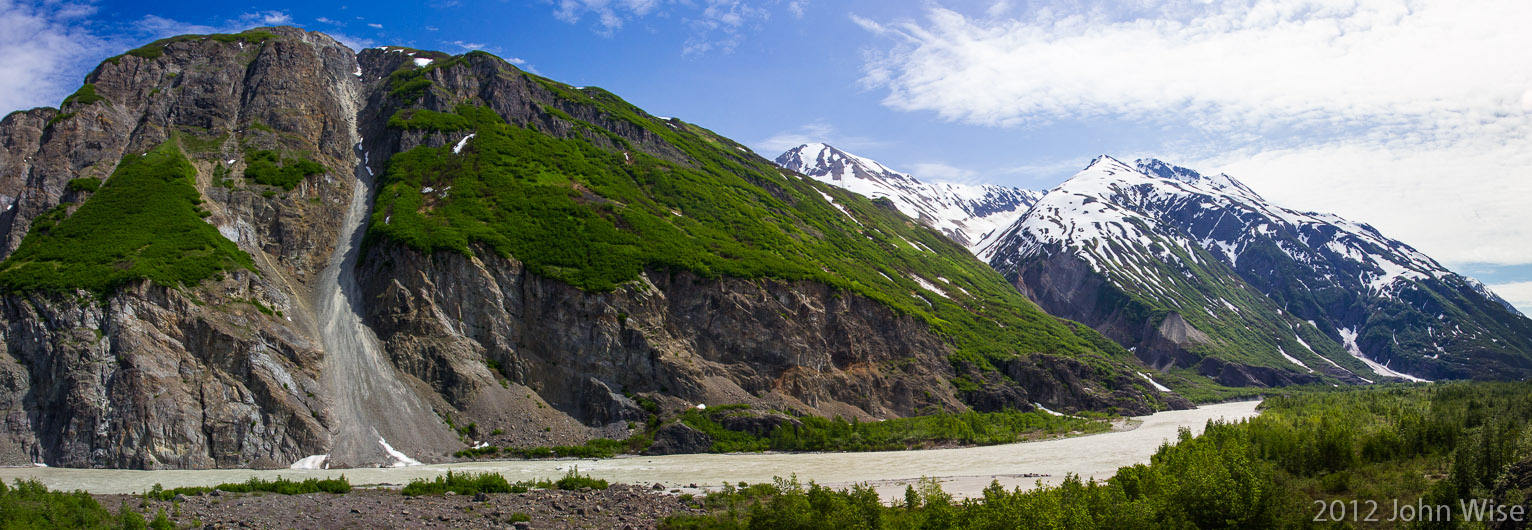
Welcome to the Tatsheshini-Alsek Provincial Park in British Columbia, Canada – we have arrived. We were two hours downriver from last night’s camp before we pulled over to take a break, have lunch, and go on a short hike. Not much to see here besides the breathtaking view, snow-spotted mountains, spectacular colors of early summer, and the wild Alsek River slicing through it.

And back onto the river. Somewhere here on our journey down the Alsek, we learn that some of the turbulence of the river comes from the heavy load of silt that it carries downstream. What happens is that as the silt settles on the river bottom, it builds up temporary berms until the force of the flowing water collapses the underwater hillsides, and water crashes down into where the silt had been. We, of course, will never see this action, as the water is so turbid and full of sediments that as our rafts glide down the river, their rubber bottoms amplify the sandpaper-like sounds of a trillion grains of former mountains that scratch at our boats.

Every view is magnificent, every angle worthy of a photo. Deciding which images to share with you is more difficult than choosing the words to describe where we were and what we did.

This is the first hanging glacier that we’ve seen on this river trip; it is one of the faces of Mt. Blackadar. From Wikipedia: A hanging glacier originates high on the wall of a glacial valley and descends only part of the way to the surface of the main glacier and abruptly stops, typically at a cliff.

I am looking back upriver at Mt. Blackadar, named in honor of Dr. Walt Blackadar. Back in 1971, this adventurous doctor became the first known person to have run a kayak through Turnback Canyon, which is what we will be approaching shortly. We’ll stop well before that canyon, as it is not possible for rafts to successfully navigate the four miles of river that squeeze between the Tweedsmuir Glacier and a lot of rock. We would most certainly die if we were to try. Even in a kayak, one must be familiar with extremely cold water, be an expert in rollover recovery, and, as the doctor was, be prepared to die in your kayak. To read more about Dr. Blackadar’s Alsek run, check out “Fast & Cold: A Guide To Alaska Whitewater” by Andrew Embick.

We are about 65 river miles from where we began; this is home for the next two days. Seems like a great place to take a pause and enjoy the scenery. Behind the tent is Tweedsmuir Glacier, and to the left of it is the beginning of Turnback Canyon – no, this is not the end of our trek down the Alsek.

Caroline is helping Martha Stewart prepare dinner – no, it’s still not that Martha Stewart! Don’t let the daylight fool you, it is nearly 7:00 p.m. when I snapped this photo. Dinner got a late start, as making camp has been a more laborious bit of work today. Not only did we have to set up the kitchen and pitch our tents, but the rafts were pulled out of the river and dragged ashore.

We need to empty the rafts of all of their contents and then deflate the rafts, we are getting ready for a helicopter portage that will take place the day after tomorrow. After we break all of this equipment down, we’ll stack it up on netting that has a connection for a cable and hook that hangs from the bottom of the helicopter for picking up our gear and moving it 8 miles downriver. Until then, we’ll chill out and admire the Tweedsmuir Glacier.

Our view of the Tweedsmuir Glacier is a pretty nice place here in British Columbia! Thanks, Canada, for the good times.

We must be approaching salmon country, as this juvenile bald eagle is the hint that good fishing is just around the corner. In Turnback Canyon, the Alsek can flow up to 25 miles per hour, too fast for salmon to swim through, so eagles have little reason to go much further upstream of here. Like this majestic bird, we have little to do but look around our surroundings.

From high in the sky to down here resting on a bloom, my gaze shifts from the mighty eagle to the fragile Northern Blue Butterfly, aka Lycaeides idas. On the day I was inspecting this guy, I had no idea what kind of butterfly I was looking at, nor did I know that between 75-80 species of butterflies live in the Alaska area. Want to know more about Alaskan butterflies before you visit? Try the pages of Mary Hopson’s TurtlePuddle.

Dinner is finished; nothing left to do but watch the river flow and hope for the glacier to calve off a new iceberg. If all of this sounds oh-so normal, forget it. Caroline and I are in a constant state of astonishment. None of this feels normal. There is nearly no way to give a sense of place while one is on this river. No single moment feels like any other. Not a single part of the scenery looks familiar, nor does it become so. Every minute is a new series of images and sensations that vie for a place in our memories. It is as though one were watching a 17-hour-a-day surrealist art film that continually puts on display an ever-changing motif. Just as the splashing flow of water never repeats an exact pattern, so does the rest of the environment that surrounds it. Long live bewilderment.

So it’s not a rainbow, but who cares? We’ve already had plenty of those. Now it’s time for a sun dog and a perfect end to another perfect day on the river.